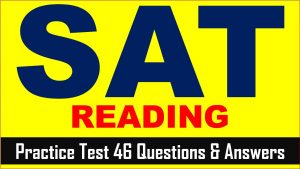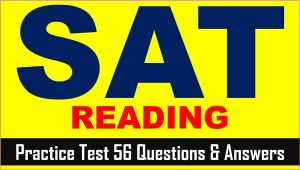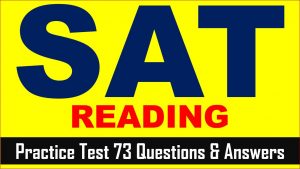SAT (Scholastic Assessment Test) is a standard test, used for taking admission to undergraduate programs of universities or colleges of the United States. SAT is developed and published by the College Board, an organization in the United States, administered by the Educational Testing Service. In this article of AKVTutorials, you will get SAT Reading Practice Online Test 40 | SAT 2024 Online Tutor AMBiPi.
SAT Reading Practice Passage
This passage is adapted from Daniel Chamovitz, What a Plant Knows: A Field Guide to the Senses. ©2012 by Daniel Chamovitz.
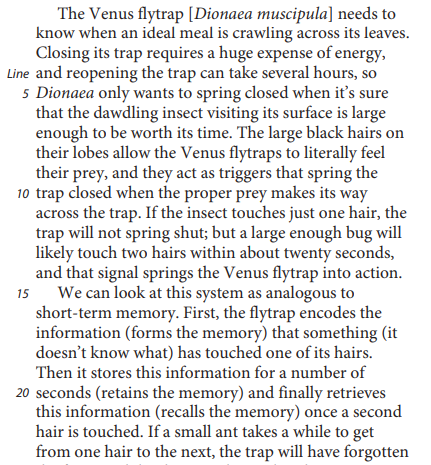
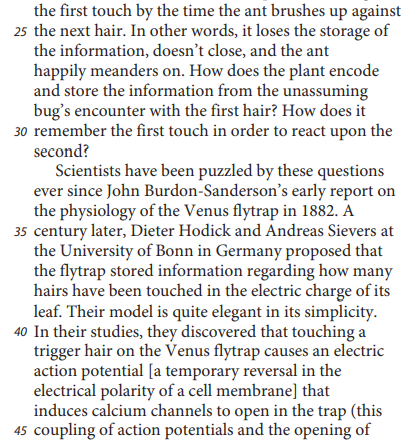
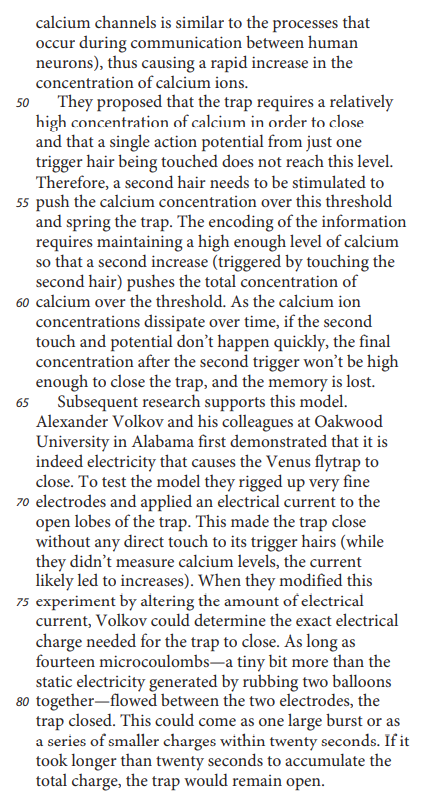
SAT Reading Comprehension Practice Test Questions
SAT Practice Test 40 Question No 1
The primary purpose of the passage is to
Option A: discuss findings that offer a scientific explanation for the Venus flytrap’s closing action.
Option B: present research that suggests that the Venus flytrap’s predatory behavior is both complex and unique among plants.
Option C: identify the process by which the Venus flytrap’s closing action has evolved.
Option D: provide a brief overview of the Venus flytrap and its predatory behavior.
SAT Practice Test 40 Answer No 1
Show/Hide Answer
Option A :
The first two paragraphs of the passage describe the physical process by which the Venus flytrap closes its trap but also note certain long-standing questions about that process: “How does the plant encode and store the information from the unassuming bug’s encounter with the first hair? How does it remember the first touch to react upon the second?” The passage then answers those questions by discussing, in the third and fourth paragraphs, a study conducted by Dieter Hodick and Andreas Sievers that identified the physiological means behind the closing of the Venus flytrap’s trap and, in the last paragraph, a study conducted by Alexander Volkov that confirmed and built on Hodick and Sievers’s findings. The primary purpose of the passage can therefore be seen as discussing scientific findings that explain how the Venus flytrap closes its trap.
Choice B is incorrect because the passage doesn’t discuss the Venus flytrap’s ability to close its trap in the context of the abilities of other plants. Choice C is incorrect because the passage discusses how the closing action operates but not how it has evolved. Choice D is incorrect because the passage doesn’t provide an overview of the Venus flytrap and its predatory behavior; it merely notes in passing that the closing action has a predatory function.
SAT Practice Test 40 Question No 2
Based on the passage, a significant advantage of the Venus flytrap’s requirement for multiple triggers is that it
Option A: enables the plant to identify the species of its prey.
Option B: conserves the plant’s calcium reserves.
Option C: safeguards the plant’s energy supply.
Option D: prevents the plant from closing before capturing its prey.
SAT Practice Test 40 Answer No 2
Show/Hide Answer
Option C :
The first paragraph discusses the challenge posed to the Venus flytrap by the opening and closing of its trap: “Closing its trap requires a huge expense of energy, and reopening the trap can take several hours, so Dionaea only wants to spring closed when it’s sure that the dawdling insect visiting its surface is large enough to be worth its time.” Since closing and reopening the trap requires the expense of precious energy, it can be inferred that by guarding against unnecessary closing, multiple triggers safeguard the plant’s energy supply.
Choice A is incorrect because the passage never indicates that multiple triggers allow the Venus flytrap to identify which species its prey belongs to, only that they allow it to gauge the prey’s size. Choice B is incorrect because although the passage implies that the plant needs to conserve energy and indicates that calcium is involved in the trap closing mechanism, there is no indication that the plant’s calcium reserves themselves require conservation. Choice D is incorrect because it can be inferred from the passage that the advantage of multiple triggers is that they prevent the Venus flytrap from closing on the improper prey rather than from prematurely closing on the proper prey; the passage never implies that when touched by its proper prey, the Venus flytrap is at risk of losing too soon to capture it.
SAT Practice Test 40 Question No 3
Which choice provides the best evidence for the answer to the previous question?
Option A: Lines 3-7 (“Closing… time”)
Option B: Lines 7-11 (“The large… across the trap”)
Option C: Lines 11-14 (“If the… action”)
Option D: Lines 16-18 (“First… hairs”)
SAT Practice Test 40 Answer No 3
Show/Hide Answer
Option A :
The previous question asks what the Venus flytrap gains from requiring multiple triggers before closing. The answer, that multiple triggers allow the plant to conserve energy, is best supported near the beginning of the first paragraph: “Closing its trap requires a huge expense of energy, and reopening the trap can take several hours, so Dionaea only wants to spring closed when it’s sure that the dawdling insect visiting its surface is large enough to be worth its time.”
Choices B, C, and D are incorrect because the cited lines don’t support the answer to the previous question. Instead, they describe how the hairs on the Venus flytrap function and how the system of multiple triggers works (choices B and C) and explain how the plant preserves a memory, as it were, that something has touched the trigger hairs (choice D).
SAT Practice Test 40 Question No 4
The use of the phrases “dawdling insect” (line 6), “happily meanders” (line 27), and “unassuming bug’s encounter” (lines 28-29) in the first two paragraphs establishes a tone that is
Option A: academic.
Option B: melodramatic.
Option C: informal.
Option D: mocking.
SAT Practice Test 40 Answer No 4
Show/Hide Answer
Option C :
The phrases “dawdling insect,” “happily meanders,” and “unassuming bug’s encounter” is less typical of word choices made informal, scientific writing than of those made in less formal writing modes. Therefore, the tone that these phrases establish is best described as informal.
Choices A, B, and D are incorrect because the phrases establish an informal tone, not academic (choice A), melodramatic (choice B), or mocking (choice D).
SAT Practice Test 40 Question No 5
In the second paragraph (lines 15-31), the discussion of short-term memory primarily functions to
Option A: clarify an explanation of what prompts the Venus flytrap to close.
Option B: advance a controversial hypothesis about the function of electric charges found in the leaf of the Venus flytrap.
Option C: stress the distinction between the strategies of the Venus flytrap and the strategies of human beings.
Option D: emphasize the Venus flytrap’s capacity for retaining detailed information about its prey.
SAT Practice Test 40 Answer No 5
Show/Hide Answer
Option A :
The first paragraph describes the mechanism that prompts the Venus flytrap to close its trap. The second paragraph makes an analogy of each step of that mechanism to an aspect of short-term memory formation in humans and then poses questions about the precise physiological terms in which those steps are carried out. It can therefore be said that the discussion of short-term memory serves to clarify the first paragraph’s explanation of what prompts the trap of the Venus flytrap to close.
Choice B is incorrect because it is the third paragraph, not the second, that discusses the function of electric charges in the Venus flytrap; moreover, the passage presents this function as a fact, not as a controversial hypothesis. Choice C is incorrect because rather than stressing the differences between Venus flytraps and humans, the analogy in the second paragraph stresses their superficial similarities. Choice D is incorrect because the second paragraph implies that the Venus flytrap’s capacity for retaining information is far from detailed: “something (it doesn’t know what) has touched one of its hairs.”
SAT Practice Test 40 Question No 6
According to the passage, which statement best explains why the Venus flytrap requires a second trigger hair to be touched within a short amount of time for its trap to close?
Option A: The second trigger produces an electrical charge that reverses the charge produced by the first trigger.
Option B: The second trigger stabilizes the surge of calcium ions created by the first trigger.
Option C: The second trigger prompts the calcium channels to open.
Option D: The second trigger provides a necessary supplement to the calcium concentration released by the first trigger.
SAT Practice Test 40 Answer No 6
Show/Hide Answer
Option D :
The third paragraph explains that touching a single trigger hair results in “a rapid increase in the concentration of calcium ions” in the plant. The fourth paragraph further explains that the calcium concentration produced by this initial touch isn’t enough to cause the trap to close, but that a second hair touch will bring the total concentration to the level necessary to close the trap: “a second hair needs to be stimulated to push the calcium concentration over this threshold and spring the trap.”
Choices A and B are incorrect because the fourth paragraph explains that the second trigger supplements the action of the first trigger, not that it reverses it (choice A) or stabilizes its effect (choice B). Choice C is incorrect because the third paragraph clearly states that the calcium channels open after the first trigger hair is touched, not the second.
SAT Practice Test 40 Question No 7
Which choice describes a scenario in which Hodick and Sievers’s model predicts that a Venus flytrap will NOT close around an insect?
Option A: A large insect’s second contact with the plant’s trigger hairs results in a total calcium ion concentration above the trap’s threshold.
Option B: A large insect makes contact with a second trigger hair after a period of inactivity during which calcium ion concentrations have diminished appreciably.
Option C: A large insect’s contact with the plant’s trigger hairs causes calcium channels to open in the trap.
Option D: A large insect’s contact with a second trigger hair occurs within ten seconds of its contact with the first trigger hair.
SAT Practice Test 40 Answer No 7
Show/Hide Answer
Option B :
The fourth paragraph explains that the Venus flytrap will close only if a second hair is stimulated to “push the calcium concentration over this threshold and spring the trap.” But the last sentence of the paragraph notes that the calcium concentrations “dissipate over time,” and if enough time elapses after the first trigger, “the final concentration after the second trigger won’t be high enough to close the trap.” It can be inferred, then, that if a large insect didn’t touch a second trigger hair until after the calcium ion concentrations had diminished appreciably, the Venus flytrap would fail to close.
Choice A is incorrect because the fourth paragraph makes clear that if the calcium concentration goes above the trap’s threshold, the plant will close, not remain open. Choice C is incorrect because as the third paragraph explains, the touching of the trigger hair and opening of the calcium ion channels don’t act to keep the trap open but are instead a precondition for the closing of the trap (though closing will occur only if a second trigger hair is touched). Choice D is incorrect because the last sentence of the fifth paragraph explains that the threshold for the time that can elapse between the touching of the first and second trigger hair is twenty seconds, meaning that a large insect touching two hairs within ten seconds would almost certainly make the plant close.
SAT Practice Test 40 Question No 8
As used in line 67, “demonstrated” most nearly means
Option A: protested.
Option B: established.
Option C: performed.
Option D: argued.
SAT Practice Test 40 Answer No 8
Show/Hide Answer
Option B :
The second sentence of the last paragraph says that Alexander Volkov and his colleagues “first demonstrated that it is indeed electricity that causes the Venus flytrap to close.” In this context, the word “demonstrated” most nearly means established.
Choices A, C, and D are incorrect because in the context of scientists showing what causes the Venus flytrap to close, the word “demonstrated” most nearly means established, not protested (choice A), performed (choice C), or argued (choice D).
SAT Practice Test 40 Question No 9
Based on the passage, what potential criticism might be made of Volkov’s testing ofHodick and Sievers’s model?
Option A: Volkov’s understanding ofHodick and Sievers’s model was incorrect.
Option B: Volkov’s measurements did not corroborate a central element ofHodick and Sievers’s model.
Option C: Volkov’s direct application of an electrical current would have been objectionable to Hodick and Sievers.
Option D: Volkov’s technology was not available to Hodick and Sievers.
SAT Practice Test 40 Answer No 9
Show/Hide Answer
Option B :
As described in the third paragraph, Hodick and Sievers’s model emphasizes that the Venus flytrap closes using an electrical charge triggered when the plant’s hairs are touched. But as explained in the last paragraph, when Alexander Volkov tested this model, the design of his experiment involved the direct application of an electrical charge, which “made the trap close without any direct touch to its trigger hairs.” Therefore, Volkov’s work could be criticized because his design omitted, rather than corroborated, a central element of Hodick and Sievers’s model— namely, the physical stimulation of the hairs.
Choice A is incorrect because although the last paragraph explains that Volkov omitted an element of Hodick and Sievers’s model when designing his experiment, there is no suggestion that he did so out of a faulty understanding of their model. Choice C is incorrect because it is impossible to know from the passage if Hodick and Sievers would have objected to Volkov’s methods. Choice D is incorrect because the passage doesn’t indicate whether the technology Volkov used had been available to Hodick and Sievers when they formulated their model.
SAT Practice Test 40 Question No 10
Which choice provides the best evidence for the answer to the previous question?
Option A: Lines 66-69 (“Alexander… close”)
Option B: Lines 69-71 (“To test… trap”)
Option C: Lines 71-74 (“This… increases”)
Option D: Lines 74-77 (“When… close”)
SAT Practice Test 40 Answer No 10
Show/Hide Answer
Option C :
The previous question asks what potential criticism might be made of Volkov’s testing of Hodick and Sievers’s model. The answer, that a central element of that model wasn’t corroborated by Volkov’s measurements, is best supported in the last paragraph: “This made the trap close without any direct touch to its trigger hairs (while they didn’t measure calcium levels, the current likely led to increases).” Because of the physical touch to the hairs figured in Hodick and Sievers’s model, it can be said that Volkov’s decision to apply an electrical current directly to the plant means that he failed to corroborate a central element of their model.
Choices A, B, and D are incorrect because the cited lines don’t support the answer to the previous question. Instead, they summarize the basic agreement of Volkov’s work with Hodick and Sievers’s model (choice A) and describe steps in Volkov’s experimental design that are related to the application of an electrical current but don’t directly address the omission of the central element of the physical touch to the hairs (choices B and D).

